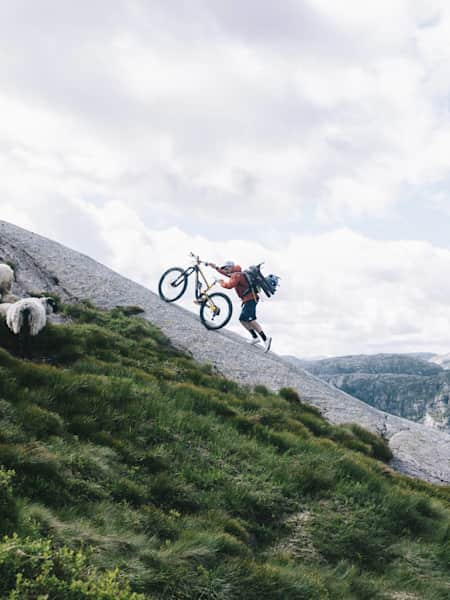The idea behind Everesting couldn’t be much simpler: cycle up and down a hill until you’ve tallied 8,848m of ascent – the height of Mount Everest. The reality is a relentless endurance battle that'll push you to your physical and mental limits. Succeed, and you’ll become a member of the elite HELLS 500 club.
It’s a challenge more and more people are undertaking, often to raise money for charity and good causes. In fact, Rebecca Rusch is encouraging people to give it a go as part of her Giddy Up Challenge, which you can take part in May 23-25 2020.
To give you the inside track on what it is, how to do it, and just how big a challenge you’ll be biting off, we chatted to Sir Guy Litespeed (a nickname given by his cycling friends; he's not a certified Knight of the Round Table) who counts himself as one of the UK’s most prolific Everesters.
How Everesting started
In 1994, George Mallory (grandson of the British mountaineer of the same name) cycled up Australia’s Mount Donna Buang 10 times, clocking 8,848m. Feeling inspired, a group of Melbourne-based cyclists, collectively known as the HELLS 500 club, made the challenge official in 2014. Andy van Bergen, founder of HELLS 500, then set up everesting.cc to connect fellow Everesters, regulate each climb, and showcase success in the Hall of Fame.
How to do Everesting: the rules
To Everest, you need to log 8,48m of ascent on any hill, climb or peak in the world. You must doing it in a single stint; breaks are allowed, but sleep isn’t, and typical attempts take around 24 hours.
For your Everesting attempt to be approved, you must:
- Record 8,848m (29,029ft) of total elevation gain
- Follow one route on one hill
- Descend on the same route you climb
- No sleep – you must complete the challenge in a single stint
- Breaks (eating, drinking, recharging) are included in your time
- You must reach the summit of the hill every time
- You must descend safely and get back home
- No time limit
If you succeed, you’ll need to upload your climb to everesting.cc where the HELLS 500 club will verify and approve your attempt, checking your performance carefully against the rule book — so make sure you’ve read it thoroughly!
If your attempt is approved, you’ll gain a place in the Hall of Fame and receive a coveted grey striped jersey to prove your prowess. Merely completing the challenge is a massive mark of achievement, and as a first-timer, your only goal should be finishing safely.
Step 1: Choose a good climb
So you’ve decided to give Everesting a go. The first step is to identify on which climb to make your attempt.
“The beauty is that you can do it on any hill, anywhere in the world. Hence, any climb on a good day can be perfect for Everesting,” explains Litespeed.
For your first attempt, he recommends staying local. It’s easier to plan, practise and manage logistics, plus you’ll have the advantage of local knowledge. Think about how busy the climb is likely to be: one packed with traffic may be unpleasant and dangerous.
The beauty is that you can do it on any hill, anywhere in the world.
“The most important thing is to pick a hill that works for you, as an individual,” he adds. “For most people, this is something like a six to eight percent, steady climb of around two or three kilometres. Gradient choice is key: too shallow and your ride will be epically long; too short and it becomes a muscle-sapping power climb."
This is very much a mental game as well, so choose a hill that plays into that. “Personally, I either want the opportunity to be the first to Everest a climb, or it has to be something very beautiful or special.”
Step 2: Prepare your kit and strategy
Anyone can turn up and start riding but to be in with a chance of success you need to plan, as Litespeed has found to his cost. “My first Everesting attempt failed due to poor logistical planning, a bad choice of climb and a lack of local knowledge – I ended up with a block headwind.”
Use kit you know works: “Everything should be tried and tested on long, climbing-orientated rides,” advises Litespeed. “Nothing should be new or unknown, from your bike and clothing to your lights and computers."
Set up a basecamp: "This is your support station, safe haven, kitchen, workshop, wardrobe, hospital and everything in-between. Whether it’s a car, van or tent it needs to be carefully positioned and stocked with everything to keep you and your bike on track."
Use nutrition you’re familiar with: “I've heard of people on their knees, crying and hallucinating, or vomiting due to too much electrolyte mix on Everesting attempts! You need a strategy that has been planned and tested.”
Get a safety plan together: "You’ll be riding at your absolute limit and struggling with a crushing lack of sleep. Night riding adds to the risk, so think about your lights, safety gear, emergency contacts and phone reception."
Set up a recharge station: Keeping your Garmin, lights and other essentials powered up can be tricky. Again, follow Litespeed's advice: come up with a strategy and practise it in advance.
Develop a strategy: Litespeed recommends breaking the challenge into chunks: “8,848m sounds ridiculous, but 8 x 1,000m is more workable. 100 laps sounds awful, but 10 x 10 laps might be OK. Reward yourself between sets, have people around you and listen to an audiobook."
Step 3: Choose the right time to make your attempt
Weather, day light hours and road conditions can all have an impact on how successful your Everesting attempt might be. “Everestings can be completed in some pretty questionable weather, even in winter,” says Guy. “For me, I want as much daylight as possible, so May, June and July are optimal. They’re also more likely to offer up warm, dry weather and lighter winds."
Days of the week and seasons can also contribute to other factors such as how busy your chosen road climb might be, which is another reason why local knowledge is useful. If you know that Saturdays are busy but Sundays are quiet, that can inform when you decide to make your attempt.
You’re attempt is also likely to take 24 hours which means you may be starting and finishing in the dark. Give yourself an early start at dawn or even before to give yourself the most daylight hours possible.
Just how hard is Everesting, and how do I know that I’m ready?
“Make no mistake, Everesting is very hard,” warns Litespeed. “Physically demanding and mentally challenging, it's a 20-24hr effort for most cyclists. Your legs can get you to around 6,000m in elevation gain, then your head needs to take over and force you up the final 2,848m when your body is screaming for you to stop!”
“You don’t have to register an attempt in advance, so we'll never know how many people fail vs those who succeed, but I suspect that the vast majority fail,” he comments. “Each Everesting I attempt is still really hard. I fear each Everesting as it approaches, regardless of my previous successes." Knowing you’re in a good place physically and mentally can be a large part of the battle.
“As I’ve said, your legs need to get you to 6,000m and your head has to get you the rest of the way. That means I need to be comfortable riding 250km and climbing 6,000m, probably over a 10 to 12-hour period. If I can do that, I can probably succeed. That's my 'ready' measure.”
Add to that detailed planning, preparation and research, and when you roll up the bottom of that climb for the first time, you’ll know you’ve done everything you can to give yourself the best possible chance of succeeding. After that, it’s just you versus the challenge.
Finally, if you’ve decided to give it a go as part of the Giddy Up Challenge, and you’re looking for more advice and support, take a look at Sir Guy Litespeed’s website. It documents his Everesting attempts and other epic cycles, and has expert advice for Everesting newbies.














